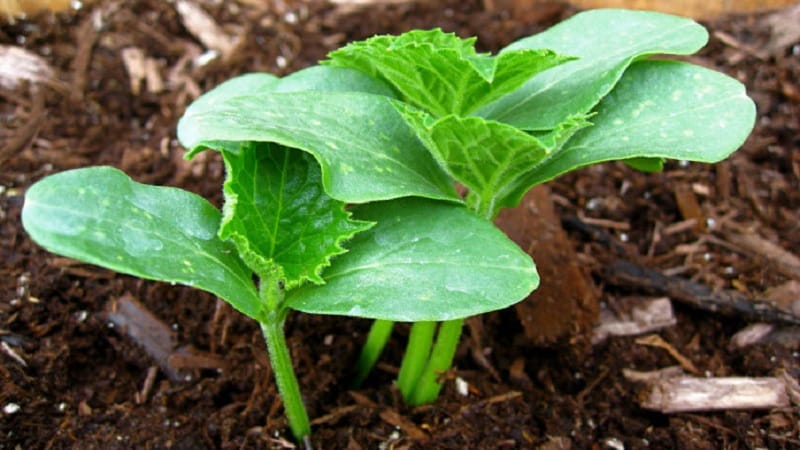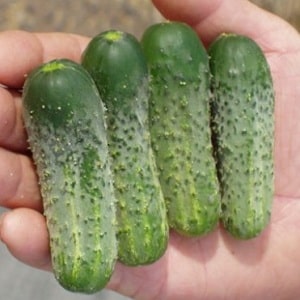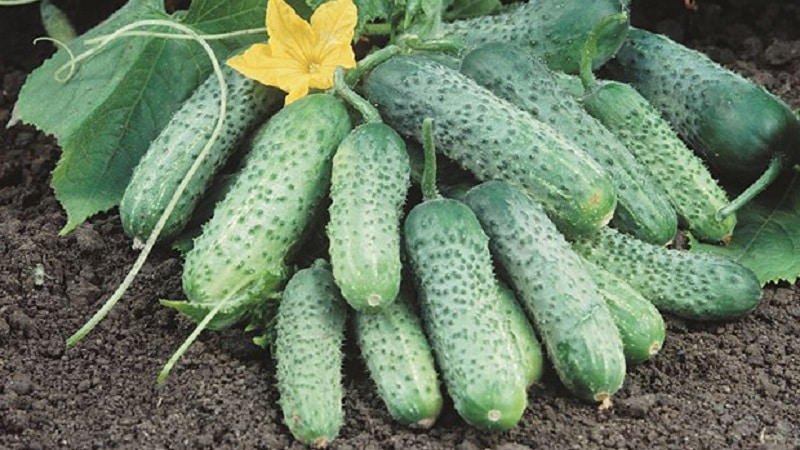Review of the Pasamonte cucumber variety: advantages and disadvantages, features of agricultural technology
Parthenocarpic cucumber Pasamonte f1 is a high-yielding hybrid of Dutch selection. The culture is distinguished by a short ripening period, excellent taste and a complete absence of bitterness. In this material, we have prepared for you information about methods of growing a hybrid, its distinctive features, advantages and disadvantages.
Description of the hybrid
The Dutch hybrid Pasamonte f1 was bred by breeders of the Syngenta seeds company and included in State Register Russia in 1997. Approved for cultivation in the Central and Middle Volga regions in open and closed ground.
Plants are medium-sized, medium-climbing. 2-3 greens are formed in one node. The fruits are not prone to overgrowth.
The hybrid belongs to parthenocarpics - plants with a female type of flowering. Male flowers do not take part in fertilization.
Pictured are Pasamonte cucumbers.

Distinctive features
The characteristics of the hybrid are collected in the table.
| Indicators | Characteristic |
| Ripening period | Early ripening, harvested 40–43 days after germination |
| Pollination type | Parthenocarpic |
| Weight | 67–120 g |
| Length | 6–9 cm |
| Form | Cylindrical, medium ribbed |
| Coloring | Emerald green with dark green longitudinal stripes and medium spotting |
| Leaves | Lightly corrugated, medium to large, light green to green in color |
| Pulp | Crispy, refreshing, not watery, virtually seedless |
| Taste | Without bitterness |
| Skin | Thin, coarsely tuberous, with white spines |
| Purpose | Universal |
| Productivity | 269–329 c/ha |
| Sustainability | To brown spot, cucumber mosaic |
| Transportability | High |
Composition and KBJU
Nutritional value of cucumbers (per 100 g):
- calorie content – 14 kcal;
- proteins – 0.8 g;
- fats – 0.1 g;
- carbohydrates – 2.5 g;
- water – 95 g;
- fiber – 1 g.
Cucumbers are a storehouse of vitamins and minerals:
- vitamin A;
- beta-carotene;
- vitamins B1, B2, B4, B5, B6, B9;
- vitamin C;
- vitamin E;
- vitamin H;
- vitamin K;
- vitamin PP;
- potassium;
- calcium;
- silicon;
- magnesium;
- sodium;
- sulfur;
- phosphorus;
- chlorine;
- iron;
- iodine;
- manganese;
- copper;
- selenium;
- fluorine;
- chromium;
- zinc.
Benefit
Thanks to their rich composition, cucumbers have many beneficial properties:
- remove salts;
- improve metabolism;
- remove free radicals;
- dilate blood vessels and capillaries;
- normalize blood pressure;
- remove “bad” cholesterol;
- dissolve sand and kidney stones;
- stimulate insulin production;
- eliminate bad breath;
- improve the properties and composition of blood.
How to grow a hybrid yourself
Pasamonte cucumbers are grown through seedlings and sowing in open ground. Caring for the crop is standard and requires compliance with the watering and fertilizing schedule, loosening and weeding of the area.
Planting by seedlings

The seedling method of growing cucumbers significantly reduces the ripening time. Even in open ground, the harvest begins two weeks earlier compared to cucumbers grown in a greenhouse using direct sowing.
Hybrid seeds do not require pre-sowing disinfection or soaking with growth stimulants. The seed material is processed in production.
To grow strong and healthy seedlings, use nutritious soil: 1 part sawdust, 2 parts peat and humus. Add 2 tbsp to a 10 liter bucket. l. ash and 1.5 tbsp. l. nitrophoska.
The mixture is thoroughly mixed and distributed into plastic or peat containers to the top. Seeds embed to a depth of 1-2 cm, 1 pc. into each container and water with warm, settled water.
At the stage of 2-3 true leaves, seedlings are fed with a nutrient solution: 3 tsp. nitrophoska (nitroammofoski) per 3 liters of warm water. Seedlings need to be watered abundantly, once every seven days.
After 27–32 days, the seedlings will be ready to “relocate” to a permanent location.
Holes with a depth of 10-15 cm are formed on the site, boiling water is poured over it and seedlings are planted at a distance of 50–60 cm.
Direct sowing into soil
Cucumbers are hypersensitive to cold, so for rapid germination the soil must warm up to at least +14 °C, and the air - up to +22 °C. The best time for sowing is the last ten days of May. The culture prefers light and nutritious soil from a mixture of turf, sawdust, humus and peat (1:1:1:1).
The site for sowing is chosen on the south side. The soil is dug up before winter, fertilized with humus and watered with a solution of copper sulfate (1 tsp per 3 liters of water). The seeds are planted with the narrow part down, 2 pieces at a time, to a depth of 2-3 cm with an interval of 10 cm. Next, the soil is watered generously with warm, settled water.
The area is covered with polyethylene or agrofibre to protect it from night frosts. The seeds hatch in 6–8 days.
Important! When planting, the main principle of crop rotation is observed - do not grow cucumbers in the same place year after year.
Growing and care
It is not advisable to cultivate cucumber crops near plantings of tomatoes, radishes and radishes. Healthy neighbors are dill, beans, peas, garlic, cabbage, beets, and onions.
Basic rules for successful cucumber farming:
- Loosening the beds after each watering and removing weeds.The procedure is carried out carefully, trying not to catch the roots located close to the surface of the earth.
- Mulching the soil with sawdust or peat will help reduce the amount of weeding.
- Before flowering, moderate watering is provided - once every 7 days. During the fruiting period, plants are watered at the root daily.
- Pruning of the vines is carried out during the period of rapid growth, forming the plant into one stem.
- The culture is responsive to regular feeding. In total, 4-5 portions of fertilizer are applied during the growing season.
Scheme for feeding cucumbers:
- before flowering – 1 tsp. urea and superphosphate, 1 tbsp. l. sodium humate per 10 l;
- during the fruiting period - 1 tbsp. l. nitrophoska, 20 g of chicken manure per 10 liters of water;
- subsequent feedings (every two weeks) – 1 tsp. potassium sulfate, 500 ml mullein per 10 liters of water.
Instead of fertilizers prepared independently, they use ready-made humic fertilizers “Breadwinner”, “Ideal”, “Fertility”.
Features of cultivation and possible difficulties
The agricultural technology of Pasamonte cucumbers does not differ significantly from the cultivation of other hybrids.
Vigorous plants require vertical tying to a trellis.
Cucumbers are planted behind curtain crops (sunflowers, corn) for protection from cold winds and scorching sun rays. Tall crops act as a kind of wall, behind which cucumbers feel comfortable and begin to bear fruit several days earlier.
Reference. Wing crops are sown perpendicular to the direction of the dominant winds 6–10 days before sowing or planting cucumbers.
Diseases and pests
The hybrid is immune to brown spot and cucumber mosaic and is absolutely immune to bacteriosis, powdery mildew, and gray rot of roots.
Treatment of plants with chemicals delays the fruiting of the crop. In the fight against fungi and bacteria, prevention and treatment with organic and mineral compounds are effective.
Signs of powdery mildew:
- white-yellow coating on stems and leaves;

- small brown balls (spores);
- drops of dew on greenery;
- dry leaves, curled upward;
- rot on cucumbers.
Treatment:
- A liter of curdled milk, whey or kefir per 10 liters of water. The number of treatments is not limited.
- Per liter of water 1/3 tsp. soda ash, 25 ml of liquid soap. Treat once every seven days.
- A liter jar of wood ash for 5 liters of boiling water. Leave for 24 hours, spray the bushes once every seven days.
Signs of gray rot:
- gray-brown slippery spots on stems and leaves;
- gray, indefinitely shaped spots on fruits;
- the appearance of watery gray fluff on the fruit.
For safe treatment, use the Trichodermin suspension. For irrigation, 100 ml of the drug is diluted in 10 liters. In case of severe damage, plants are treated up to 5 times a week. To prevent gray rot, before planting in the ground, the roots are dipped in a mixture of 5 liters of water, two parts of soil, one part of humus, 5 g of suspension. After two leaves appear, the seedlings are treated every two weeks.
Signs of bacteriosis:
- yellow-brown spots on cotyledon leaves with a characteristic angular shape;
- mucus from the back of the leaves;
- leaf perforation.
Treatment:
- Infuse 100 g of onion peels in 1 liter of boiling water. After 48 hours, strain the solution and dilute with water in a ratio of 1:5. Treat bushes once every 10 days after sunset.
- For 10 liters of water 1 tsp. boric alcohol and brilliant green, spray the plants once every 20 days.
Disease prevention measures:
- periodic treatment with Trichopolum (2 tablets per 1 liter of water);
- moisture level control;
- compliance with crop rotation;
- removing wilted and dry leaves;
- removing 3–5 cm of soil and removing plant debris at the end of the season;
- timely feeding;
- loosening the soil;
- choosing a sunny place for planting;
- treatment of the plot with "Gamair" before sowing;
- reduction of nitrogen in the soil;
- thinning of plantings.
Spider mites and slugs pose a particular danger to cucumbers. For prevention, the soil is dug up in the fall and left to freeze.
Folk remedies against spider mites:
- grind 1 kg of aloe vera through a meat grinder, pour in 10 liters of water and mix in 50 g of laundry soap shavings;
- pour 300 g of horse sorrel into 10 liters of water, leave for 3–5 hours;
- Pour 50 g of greens and dandelion flowers into 2 liters of water and leave for 3-4 hours.
Processing frequency is once every two weeks.
Folk remedies against slugs:
- Mix equal parts ground black pepper, wood ash and rock salt. Sprinkle the mixture into the beds and loosen.
- Dig furrows around the perimeter of the beds and pour ash and tobacco dust into them in equal parts.
- Mulch the soil with crushed eggshells, pine needles, sawdust, and river sand. Slugs do not like to crawl on such surfaces; sharp particles cut their abdomen.
- Prepare a solution of 1 liter of water and 2 tbsp. l. ammonia. Spray the bushes at night.
Harvesting and application
The fruits of the Pasamonte hybrid are not prone to overgrowth and stop growing at the stage of full ripening. The first harvest is harvested 35–40 days after germination.
Thanks to the selective work of biologists, parthenocarpic cucumbers are completely free of bitterness.Dense and crispy greens are used for preparing fresh salads, pickling and pickling.
The shelf life in the cellar or refrigerator is 10–15 days.
Advantages and disadvantages

Advantages of a hybrid:
- high productivity;
- excellent presentation;
- resistance to overgrowth;
- small number of seeds;
- lack of bitterness;
- versatility of use in cooking;
- early ripening;
- suitable for producing gherkins;
- parthenocarpic does not depend on the presence of pollinating insects.
Flaws:
- susceptibility to fungal and bacterial diseases;
- requirement for watering.
Reviews
Hybrid cucumber Pasamonte f1 is liked by gardeners for its high productivity, excellent taste and crispy pulp without bitterness.
Valentina, Pavlovsk: “I constantly grow cucumbers called Pasamonte in my summer cottage. The crop does not require special care and bears fruit abundantly until frost. The greens are small, pimply, very tasty and crunchy.”
Vera, Ramon: “Previously, I was very wary of hybrids and grew only domestic varieties, until I tried Pasamonte cucumbers. A friend brought the seeds from Holland. I sowed it in the garden directly into the ground. I was pleased with the result. The greens are all as chosen, identical, even and dense. The culture requires minimal care."
Andrey, Pavelets: “I grow cucumbers in a greenhouse for sale. Hybrid Pasamonte is one of the favorites. The manufacturer recommends it for cultivation in open ground, but in greenhouses it gives no worse results. Absent in fruits bitterness, no voids. The pulp is juicy, but not watery. With proper care, he rarely gets sick.”
Read also:
Early ripe Parisian gherkin cucumbers for the most delicious winter preparations.
How to properly grow Claudia f1 cucumbers to break yield records.
Conclusion
Parthenocarpic Pasamonte f1 is a hybrid cucumber that does not require additional pollination. The crop is distinguished by its low maintenance requirements, high productivity (269–329 c/ha), and early ripening period. The plant needs frequent watering and preventive treatments against fungus, bacteria and insects.
The fruits are not prone to overgrowth and at the stage of full ripeness have a size of no more than 9 cm. Zelentsy are good fresh, ideal for canning, do not taste bitter.